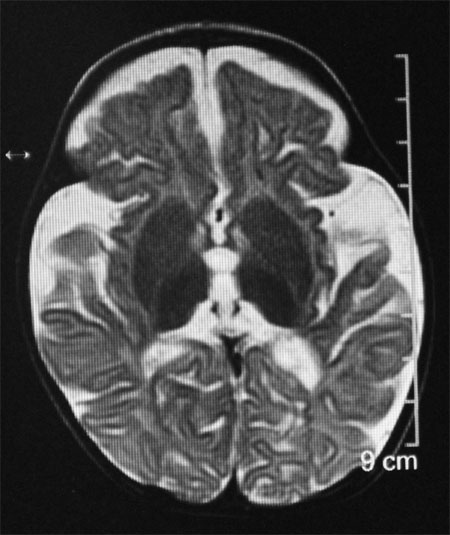|
|
|
Indian Pediatr 2018;55: 707 |
 |
AEFI Surveillance – The Learning Curve Continues
|
|
Vidushi Mahajan1 and Rekha Gupta2
Departments of 1Pediatrics and 2Radiology,
Government Medical College and Hospital, Chandigarh, India.
Email:
[email protected]
|
|
A 3-month-old girl was brought to pediatric emergency services of our
hospital two days after second dose of pentavalent vaccine. She had
fever and three episodes of generalized tonic clonic seizures, which
were interspersed over 24 hours and each lasted for approximately 1
minute. There was no family history of epilepsy. The child was reported
to the authorities as Adverse event following immunization (AEFI). She
was hemodynamically stable, lethargic with no focal neurological
deficit. Her systemic examination and optic fundus was normal. Her blood
investigations (blood sugar, electrolytes and ionized calcium) as well
as CSF examination were normal. Ultrasound head showed prominent lateral
and third ventricles. Child was treated with phenobarbitone and during
her hospital stay of 4 days, she remained seizure-free, and received
breast feeds exclusively. She was discharged on antiepileptics in a
stable condition with MRI and EEG being planned on follow-up. Four days
later, the baby was brought in a state of cardiac arrest. History
revealed that she had turned lethargic and then apneic. Resuscitation
was performed as per protocol but she could not be revived. Parents
refused autopsy. MRI brain done post-discharge and collected
posthumously showed prominent extra-axial CSF spaces in frontotemporal
region, cerebral convexities with widened sylvian fissures bilaterally
and uniform thinning of corpus callosum (Fig. 1). These
findings were highly suggestive of Glutaric Aciduria type 1 [1].
 |
|
Fig.1 T2W images of MRI brain showing
bilateral frontotemporal atrophy with widened sylvian fissures
(the bat wings sign) seen in Glutaric Aciduria Type 1.
|
As per AEFI surveillance, any death following AEFI is
reported to District Immunization Officer. Recently, increasing number
of deaths after Pentavalent immunization have been reported from
different parts of country, which is likely due to an improving
surveillance program [2]. However, even a single case of serious AEFI
evokes lot of media attention and scare among the general public. Hence,
it is highly imperative that all efforts should be made to establish
causality right at the hospital level immediately after the event [3].
References
1. Santos CS, Roach SE. Glutaric aciduria type I: A
neuroimaging diagnosis? J Child Neurol. 2005; 20:588-90.
2. Puliyel J, Kaur J, Puliyel A, Sreenivas V. Deaths
reported after pentavalent vaccine compared with death reported after
diphtheria-tetanus-pertussis vaccine: An exploratory analysis. Medical
Journal of Dr. D.Y. Patil Vidyapeeth. 2018;11:99-105.
3. Pfluger T, Weil S, Muntau A, Willemsen UF, Hahn K. Glutaric
aciduria type 1: A serious pitfall if diagnosed too late. Eur Radiol.
1997;7:1264-6.
|
|
|
 |
|

